
Intel has officially introduced its Lunar Lake series of processors, the Core Ultra 200V lineup, promising to revolutionize performance and efficiency for thin and light laptops. As Intel’s latest answer to Qualcomm’s Snapdragon X Elite and AMD’s Strix Point chips, the Core Ultra 200V family is designed to offer unmatched speed, better graphical capabilities, and cutting-edge AI processing. With these new processors, Intel aims to meet or surpass its competitors in almost every aspect, from battery life to raw power.
The Lunar Lake chips are set to debut in a variety of laptops starting from September 24th, 2024, and Intel has made bold claims about their performance. According to the company, these chips will bring “the fastest CPU core,” “the world’s best built-in GPU,” and “the best AI performance,” to modern laptops, marking a new era for portable computing.
Unprecedented Battery Life
One of the most significant claims surrounding Intel’s Core Ultra 200V chips is their efficiency, especially when it comes to battery life. For example, Dell’s flagship XPS 13 laptop, featuring the Lunar Lake chip, is expected to boast up to 26 hours of continuous 1080p Netflix streaming at 150 nits of brightness. This represents a 44% increase from the previous model, which achieved around 18 hours. Intel’s advancements in energy efficiency, along with the integration of memory into the CPU package, contribute to this impressive leap. For comparison, Qualcomm’s XPS 13 model claims 27 hours of battery life, showing just how competitive the new chips are.
The improvement in battery life is a significant selling point for the Core Ultra 200V processors, particularly for users who rely heavily on their laptops throughout the day. Whether for professional use, streaming, or gaming, longer battery life means fewer interruptions and greater productivity on the go.
Gaming Performance: Intel Surges Ahead
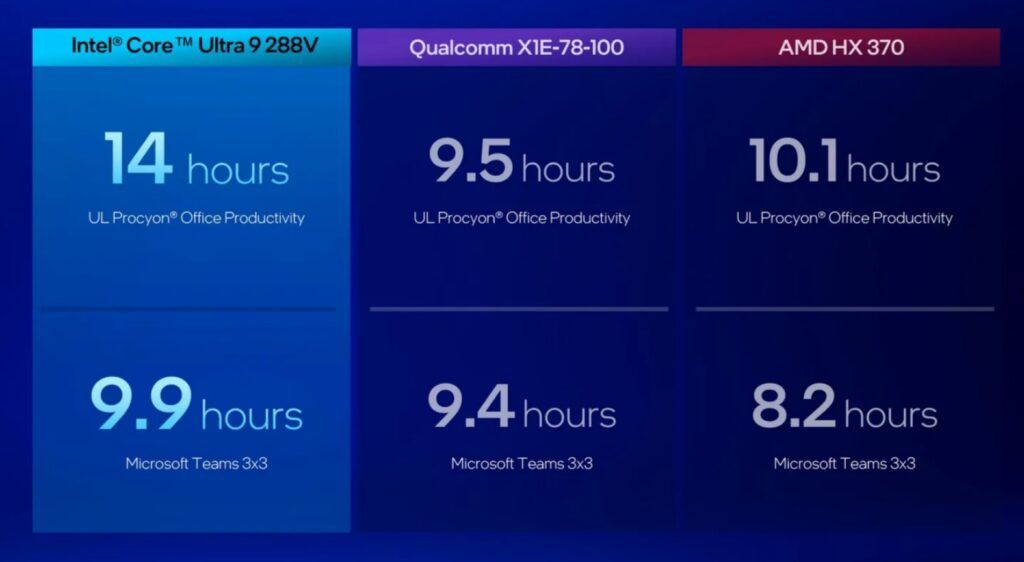
In the realm of gaming, Intel is positioning itself as a leader with its Core Ultra 9 288V chip, which delivers up to 68% better frame rates than Qualcomm’s top-tier X1E-84-100 chip. The comparison is based on frame rates from popular games tested on a Samsung Galaxy Book4 Edge equipped with Qualcomm’s chip. Additionally, Intel’s chip outpaces AMD’s HX 370 by 16% in gaming performance on the Asus Zenbook S 16.
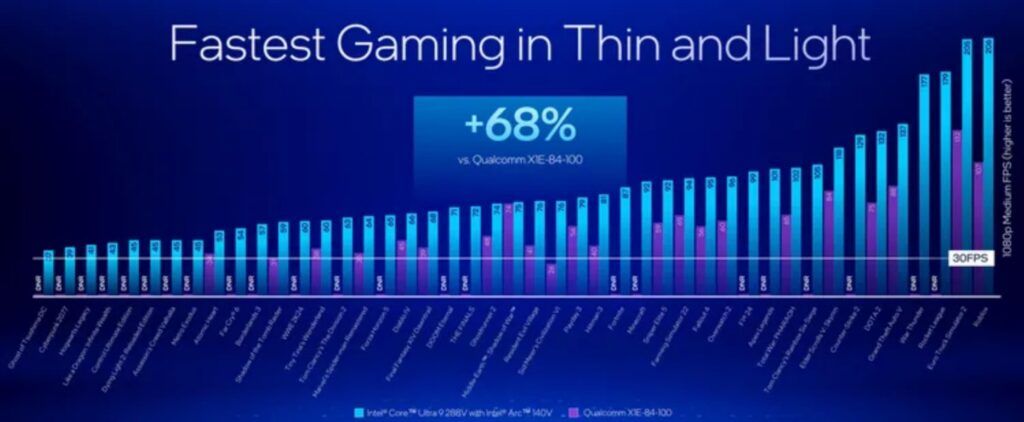


Intel’s XeSS upscaling technology further enhances the gaming experience by enabling ray tracing on integrated GPUs. With XeSS, users can enjoy graphically demanding games such as Cyberpunk 2077 at 45fps, Marvel’s Spider-Man Remastered at 57fps, and Shadow of the Tomb Raider at 66fps. These frame rates are achieved without any external GPU, underscoring Intel’s significant advancements in integrated graphics performance.
Intel’s Core Ultra 200V processors are optimized for 1080p gaming, providing a seamless experience in medium graphical settings for most titles. The ability to achieve such performance on thin and light laptops without a dedicated graphics card is a major advancement for gamers who prefer portability without compromising on quality.
AI Performance: Faster and More Efficient
Intel is also touting AI performance as a critical advantage of the Lunar Lake CPUs. With AI applications becoming increasingly important for creative professionals and everyday users alike, Intel’s Core Ultra 200V chips come equipped with enhanced AI engines that dramatically improve performance in applications such as Adobe Premiere Pro and Lightroom.
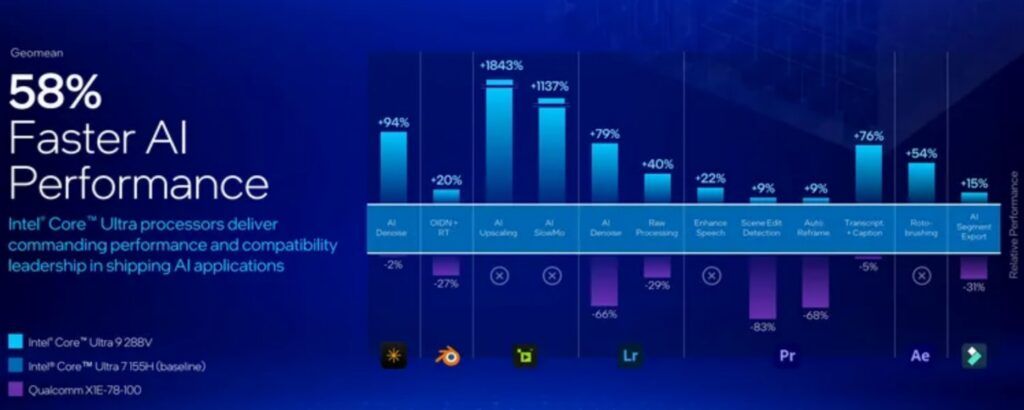
The Lunar Lake processors boast far superior AI performance compared to Qualcomm’s offerings, particularly when it comes to real-time processing. These chips are designed to handle AI-assisted tasks such as automated video editing, image processing, and more complex workflows, giving creators more power to enhance their projects quickly and efficiently.
Intel claims that their AI performance in certain tasks—like photo editing in Adobe Lightroom—is up to 86% faster than Qualcomm’s solutions. In Adobe Photoroom, the performance is said to be 145% faster compared to Qualcomm’s top AI chips, making the Core Ultra 200V the ideal choice for users who rely on creative applications.
Advanced Connectivity and Ports
Lunar Lake processors also offer cutting-edge connectivity features that make them future-proof for the next generation of laptops. These include Wi-Fi 7, Bluetooth 5.4, and Thunderbolt 4 support. With these features, users can expect faster data transfer speeds, more reliable connections, and the ability to connect multiple devices simultaneously. Thunderbolt 4, in particular, allows users to connect their laptop to multiple 4K displays, providing a comprehensive workstation setup that rivals even desktop PCs in terms of versatility.
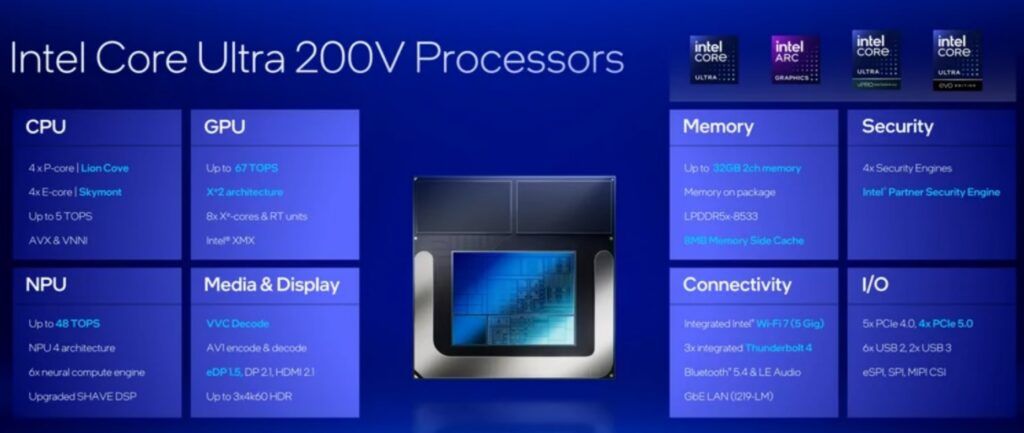
The integration of Wi-Fi 7 enables faster internet speeds and better network performance, which is particularly beneficial for professionals who work in high-bandwidth environments or rely on cloud-based services. The combination of Wi-Fi 7 and Thunderbolt 4 ensures that Lunar Lake-powered laptops are ready for the demands of modern users.
Core Architecture: Breaking Down the Lineup
One of the standout features of the Lunar Lake lineup is its simplified architecture. Gone are the days when Core i3, i5, and i7 signified a clear difference in core counts and threads. Instead, Intel has redefined its processor tiers with Core Ultra naming conventions. Each Core Ultra 200V processor features four performance cores and four low-power cores, regardless of whether it is labeled Ultra 5, Ultra 7, or Ultra 9.
The key differences between the models come down to GPU cores, AI engines, and cache size. For example, the Core Ultra 7 258V comes with eight GPU cores, six AI engines, and 12MB of cache, while the Ultra 9 288V adds more power with a 30W default TDP and higher GPU clock speeds. This means users can choose the processor that best suits their needs, whether for everyday tasks, creative work, or gaming.
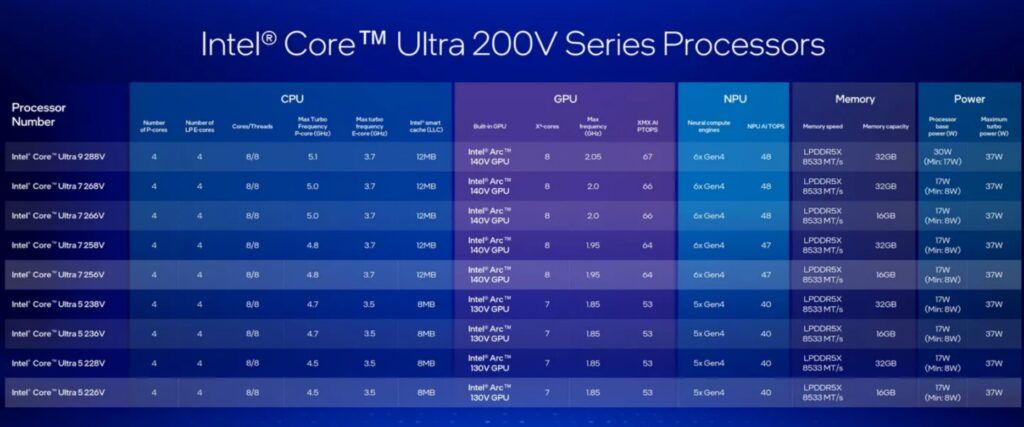
Despite these differences, all Lunar Lake processors are optimized for efficiency, with most chips operating at a 17W TDP by default. This ensures that even the most powerful models in the lineup remain energy-efficient, making them ideal for thin and light laptops.
Limitations of Lunar Lake: Not for Power Users?
While Lunar Lake excels in efficiency and portability, there are some limitations. Each Core Ultra 200V processor is capped at 8 cores and 32GB of RAM, which may not be enough for users who require more power for intensive workloads like video rendering or 3D modeling. Moreover, the integrated memory setup means that users cannot upgrade their laptop’s RAM after purchase, potentially limiting the longevity of the device.

For users who need more processing power, Intel is preparing its Arrow Lake series, which is expected to launch as early as October 2024. Arrow Lake will target power users with higher core counts, more memory options, and greater overall performance, making it the better choice for those who require maximum power.
Conclusion: Lunar Lake is a Game-Changer for Portable Laptops
With the introduction of the Lunar Lake Core Ultra 200V processors, Intel is pushing the boundaries of what’s possible in thin and light laptops. By offering top-tier performance in terms of CPU, GPU, and AI capabilities, all while maintaining excellent battery life, Lunar Lake aims to be the go-to choice for users seeking a balance between power and portability.
Whether you’re a gamer, creative professional, or simply need a reliable laptop for everyday tasks, Lunar Lake offers a compelling option. With Acer, Asus, Dell, HP, Lenovo, LG, MSI, and Samsung all preparing to release laptops with these processors, consumers will have a wide range of options to choose from.
However, potential buyers should wait for independent reviews to confirm Intel’s performance claims before making a purchase. As with any new technology, early benchmarks and hands-on testing will provide the final verdict on whether Lunar Lake lives up to the hype.

By Andrej Kovacevic
Updated on 10th March 2025